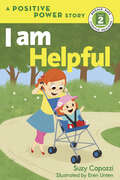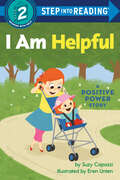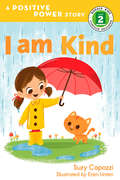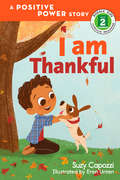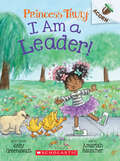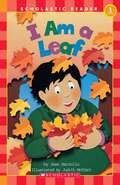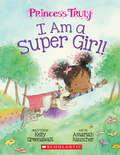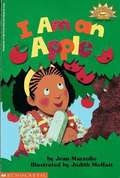- Table View
- List View
I Am Helpful (Rodale Kids Curious Readers/Level 2)
by Suzy CapozziThe little girl in I Am Helpful thought that having a baby sister would be fun. But with a different daily routine at home, and her parents constantly distracted by the family’s newest member, the little girl has a lot to adjust to. However, by helping her parents, and taking on special jobs, like singing to the baby, she learns that being a big sister comes with big rewards (though a little spit-up too). Through simply text and joyful illustrations, this final title in the Positive Power series inspires kids to help others while giving them the confidence they need to transform from little to BIG readers.Short on words and long on empowerment, the Positive Power early reader series teaches kids and parents alike the power of positive affirmations and how to incorporate them into their daily lives. Each paperback version of the book also features two pages of colorful stickers based on the story.
I Am Helpful: A Positive Power Story (Step into Reading)
by Suzy CapozziThe little girl in I Am Helpful thought that having a baby sister would be fun. But with a different daily routine at home, and her parents constantly distracted by the family’s newest member, the little girl has a lot to adjust to. However, by helping her parents, and taking on special jobs, like singing to the baby, she learns that being a big sister comes with big rewards (though a little spit-up too). Through simply text and joyful illustrations, this final title in the Positive Power series inspires kids tohelp others while giving them the confidence they need to transform from little to BIG readers.Short on words and long on empowerment, the Positive Power early reader series teaches kids and parents alike the power of positive affirmations and how to incorporate them into their daily lives.
I Am Kind: A Positive Power Story (Step into Reading)
by Suzy CapozziI Am Kind follows a little girl who sees kindness all around her. Her mother is kind when she volunteers in the community, and her neighbor is kind when he gives her strawberries from his garden. Even her nature troop is kind when they take care of the earth! The little girl realizes that she, too, has the power to be kind, and that even small actions can have a big impact. In this new installment of the Positive Power early reader series, children will learn the affirmation “I am kind” through an encouraging story of community and everyday kindness. And it includes 2 sheets of stickers!About the Positive Power Series:Short on words and long on empowerment, the Positive Power early reader series teaches kids and parents alike the power of positive affirmations and how to incorporate them into their daily lives.
I Am Kind: The Positive Power Series (Rodale Kids Curious Readers Level 2 #2)
by Suzy Capozzi Eren UntenI Am Kind follows a little girl who sees kindness all around her. <P><P>Her mother is kind when she volunteers in the community, and her neighbor is kind when he gives her strawberries from his garden. <P><P>Even her nature troop is kind when they take care of the earth! <P>The little girl realizes that she, too, has the power to be kind, and that even small actions can have a big impact. <P> In this new installment of the Positive Power early reader series, children will learn the affirmation “I am kind” through an encouraging story of community and everyday kindness. <P>About the Positive Power Series: Short on words and long on empowerment, the Positive Power early reader series teaches kids and parents alike the power of positive affirmations and how to incorporate them into their daily lives.
I Am Malala: How One Girl Stood Up for Education and Changed the World
by Malala Yousafzai Patricia McCormickNIMAC-sourced textbook
I Am Malala: The Girl Who Stood Up For Education And Was Shot By The Taliban
by Malala Yousafzai Patricia McCormickNIMAC-sourced textbook
I Am Mighty: An Acorn Book (Princess Truly)
by Kelly GreenawaltPrincess Truly is strong and mighty, in these rhyming stories perfect for beginning readers!Pick a book. Grow a Reader!This series is part of Scholastic's early reader line, Acorn, aimed at children who are learning to read. With easy-to-read text, a short-story format, plenty of humor, and full-color artwork on every page, these books will boost reading confidence and fluency. Acorn books plant a love of reading and help readers grow!Princess Truly is MIGHTY! She can jump, she can twirl; her arms are strong and her legs are powerful. When her dog Sir Noodles gets stuck in a tire swing, Princess Truly uses her strength—and her magical curls—to free her chunky pug. And when Princess Truly and her little brother, Ty, visit the carnival, she uses her strength and determination to win a prize at one of the games. These funny and empowering short stories promote believing in yourself, building confidence, and having a positive self-image, and foster imagination and curiosity. With full-color artwork and easy-to-read rhyming text throughout, this series is perfect for new readers!
I Am Peter (Peter Rabbit Animation)
by Penguin Young ReadersMeet the newly animated Peter Rabbit! Donned in his father's blue coat, Peter is as frisky and adventurous as ever. His mother has given him his father's old journal--full of adventure stories, secret escape routes, and empty pages for Peter to fill in himself. This classic rabbit, along with his best friends, Lily Bobtail and Benjamin Bunny, is ready for another adventure!
I Am Powerful: A Positive Power Story (Step into Reading)
by Suzy CapozziThe Positive Power series introduce self-esteem and empathy to young readers. I Am Powerful is a fun and encouraging Step 2 Step Into Reading about believing in yourself!Even a young kid can make a difference in their community! I Am Powerful follows a young girl as she learns to trust in her abilities. In this installment of the Positive Power early reader series, children will learn the affirmation "I am powerful" through an encouraging story of self-confidence, self-empowerment and activism.Step 2 Readers use basic vocabulary and short sentences to tell simple stories, for children who recognize familiar words and can sound out new words with help. Rhyme and rhythmic text paired with picture clues help children decode the story.
I Am René, the Boy / Soy René, el niño (Into Reading, Read Aloud #Module 2, Book 1)
by René Laínez Fabiola RamírezNIMAC-sourced textbook
I Am Smart (Rodale Kids Curious Readers/Level 2)
by Suzy CapozziWhen his teacher announces that there will be a science fair in a few weeks, the young boy in I Am Smart is worried. He doesn't like science. Science is hard! But when his mom tells him to "look for the science in your life," he knows just what his project will be! By doing research, asking his friends for help, and not giving up, the boy learns that science can be really fun. Now that's smart!Short on words and long on empowerment, the Positive Power early reader series teaches kids and parents alike the power of positive affirmations and how to incorporate them into their daily lives.
I Am Smart: A Positive Power Story (Step into Reading)
by Suzy CapozziWhen his teacher announces that there will be a science fair in a few weeks, the young boy in I Am Smart is worried. He doesn't like science. Science is hard! But when his mom tells him to "look for the science in your life," he knows just what his project will be! By doing research, asking his friends for help, and not giving up, the boy learns that science can be really fun. Now that's smart!Short on words and long on empowerment, the Positive Power early reader series teaches kids and parents alike the power of positive affirmations and how to incorporate them into their daily lives. Each paperback version of the book also features two pages of colorful stickers based on the story.
I Am Strong: A Positive Power Story (Rodale Kids Curious Readers/Level 2 #3)
by Suzy CapozziI Am Strong follows a young boy on a fun-filled day as he learns what it means to be strong. Despite his small size, he surprises his teammates and himself when he demonstrates mental, emotional, and physical strength to become the Field Day champion! This third title in the Positive Power series will get kids excited about their own strengths—whether it’s learning to read or running really fast. And it includes 2 sheets of stickers!About the Positive Power Series: Short on words and long on empowerment, the Positive Power early reader series teaches kids and parents alike the power of positive affirmations and how to incorporate them into their daily lives.
I Am Strong: A Positive Power Story (Step into Reading #3)
by Suzy CapozziI Am Strong follows a young boy on a fun-filled day as he learns what it means to be strong. Despite his small size, he surprises his teammates and himself when he demonstrates mental, emotional, and physical strength to become the Field Day champion! This third title in the Positive Power series will get kids excited about their own strengths—whether it’s learning to read or running really fast. And it includes 2 sheets of stickers!About the Positive Power Series: Short on words and long on empowerment, the Positive Power early reader series teaches kids and parents alike the power of positive affirmations and how to incorporate them into their daily lives.
I Am Thankful: The Positive Power Series (Rodale Kids Curious Readers Level 2 #1)
by Suzy Capozzi Eren UntenIt’s Thanksgiving Day, and there’s a lot to be done before turkey time! I Am Thankful follows a young boy through his busy holiday adventures, from running in the turkey trot to helping his family bake pies. Even though the weather might ruin the annual family football game, the jam-packed day proves there’s never a shortage of things to be thankful for. In this first installment of the Positive Power series, kids will learn the affirmation “I am thankful” through a delightful story of food, family, and fun.About the Positive Power Series:Short on words and long on empowerment, the Positive Power early reader series teaches kids and parents alike the power of positive affirmations and how to incorporate them into their daily lives.
I Am a Good Friend!: An Acorn Book (Princess Truly #4)
by Kelly GreenawaltPrincess Truly shares her kindness, optimism, and can-do attitude with her friends, in these rhyming stories perfect for beginning readers!Pick a book. Grow a Reader!This series is part of Scholastic's early reader line, Acorn, aimed at children who are learning to read. With easy-to-read text, a short-story format, plenty of humor, and full-color artwork on every page, these books will boost reading confidence and fluency. Acorn books plant a love of reading and help readers grow!Princess Truly knows how to be a good friend! With a twinkle from her magical, sparkling curls and her can-do attitude, she helps her friends Lizzie and May build a best friends' clubhouse. Then they have a sleepover with all their pets! And when Lizzie's kitty is wide awake at the end of the night, Princess Truly "rocks" him to sleep with a jamming bedtime song. These funny and empowering short stories with full-color artwork and easy-to-read rhyming text throughout are perfect for new readers!
I Am a Leader!: An Acorn Book (Princess Truly)
by Kelly GreenawaltPrincess Truly takes the lead, across three rhyming stories perfect for beginning readers!Pick a book. Grow a Reader!This series is part of Scholastic's early reader line, Acorn, aimed at children who are learning to read. With easy-to-read text, a short-story format, plenty of humor, and full-color artwork on every page, these books will boost reading confidence and fluency. Acorn books plant a love of reading and help readers grow!Princess Truly leads the way! Across three stories, Princess Truly helps her friends as class leader, she knows just what to do to help her pug, Sir Noodle, when he's nervous at his talent show, and she leads lost ducklings back to their mother! These funny and empowering short stories promote believing in yourself, building confidence, and having a positive self-image. Perfect for fans of Ada Twist, Scientist, Princess Truly fosters imagination and curiosity.With full-color artwork and easy-to-read rhyming text throughout, this series is just-right for new readers!
I Am a Leaf
by Jean MarzolloRead about the different creatures that live in trees. Learn about how the trees change with the seasons.
I Am a Super Girl!: An Acorn Book (Princess Truly #1)
by Kelly GreenawaltPrincess Truly to the rescue!Pick a book. Grow a Reader!This series is part of Scholastic's early reader line, Acorn, aimed at children who are learning to read. With easy-to-read text, a short-story format, plenty of humor, and full-color artwork on every page, these books will boost reading confidence and fluency. Acorn books plant a love of reading and help readers grow!Meet Princess Truly! With the help of her rocket boots and her magical, sparkly curls, she becomes a super girl and uses her smarts and strength to save the day. But when her friend Lizzie has a rescue mission of her own, Lizzie doesn't feel so super. Can Truly help her friend believe in herself and find her confidence? These rhyming, funny, and empowering stories with full-color artwork and easy-to-read text throughout are perfect for new readers!
I Am an Apple (Hello Reader! Science Ser.)
by Jean MarzolloIt starts with a seed and grows. Apples are delicious and can be used to make many tasty things.
I Am an Earth Scientist, Astronaut, and Explorer
by Kira Freed Kathryn SullivanNIMAC-sourced textbook

